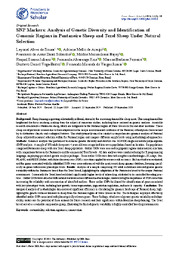SNP Markers: analysis of genetic diversity and identification of genomic regions in pantaneiro sheep and texel sheep under natural selection.
SNP Markers: analysis of genetic diversity and identification of genomic regions in pantaneiro sheep and texel sheep under natural selection.
Author(s): SOUSA, L. A. de; ARAUJO, A. M. de; DINIZ SOBRINHO, F. de A.; BAJAY, M. M.; JULIANO, R. S.; REIS, F. A.; FERREIRA, M. B.; VEGA-BRITEZ, G. D.; VARGAS JUNIOR, F. M. de
Summary: Sheep farming is growing substantially in Brazil, driven by the increasing demand for sheep meat. This rising demand has heightened the focus on sheep, making them the subject of numerous studies, including those centered on genetic analysis. A notable research area involves Pantaneiro sheep, which are indigenous to the Pantanal region of Mato Grosso do Sul and other locations. These sheep are of particular interest due to their adaptation to the unique environmental conditions of the Pantanal, a floodplain characterized by its distinctive climatic and ecological features. This study primarily aimed to conduct a comprehensive genomic analysis of Pantanal sheep subjected to natural selection within the Pantanal region and compare different sample herds using methodological approaches. Methods: Genomic analysis was performed to examine genetic diversity and structure via GGP50K single nucleotide polymorphism (SNP) analysis. A sample of 192 adult sheep over 4 years old was categorized into seven populations based on location: Six populations comprised Pantaneiro sheep with one Texel sheep population. Outlier SNPs were assessed to pinpoint regions under natural selection, with comparisons between the Pantaneiro and the commercial Texel breeds. All data analyses were conducted using the R programming language, employing specialized genetic analysis packages. These outlier SNPs were detected using three methodologies, PCAdapt, OutFLANK, and FDIST2/fsthet, with false discovery rate (FDR) corrections applied to ensure result accuracy. Each method was evaluated, and the genes associated with the identified SNPs were cross-referenced with the most recent sheep genome database, focusing specifically on genes with known phenotypic traits. Results: Analysis of a sample comprising 192 adult individuals revealed greater genetic variability within the Pantaneiro breed than the Texel breed, highlighting the adaptation of the Pantaneiro breed to the unique Pantanal environment. Conversely, the Texel breed exhibited significantly higher levels of inbreeding, attributed to its controlled breeding practices. Outlier SNPs were detected with notable variation across different methodologies, underscoring the importance of FDR correction in ensuring the reliability and concentration of identified outliers. These outlier SNPs facilitated the identification of genes associated with key phenotypic traits, including hair growth, tissue regeneration, pigmentation regulation, and muscle capacity. Conclusion: The integrated analysis of methodologies demonstrated significant efficiency in elucidating the genomic landscape of Pantanal sheep, highlighting the genetic richness inherent in sheep from the Pantanal region of Mato Grosso do Sul. The techniques employed effectively identified outlier SNPs associated with phenotypically relevant genes. These findings, which reveal greater genetic variability and adaptability, underscore the potential of these animals for future research and their significance within Brazilian sheep farming. The Texel breed served as a valuable comparative group, illustrating the limited genetic variability in highly controlled breeding environments.
Publication year: 2024
Types of publication: Journal article
Unit: Embrapa Pantanal
Observation
Some of Embrapa's publications are published as ePub files. To read them, use or download one of the following free software options to your computer or mobile device. Android: Google Play Books; IOS: iBooks; Windows and Linux: Calibre.
Access other publications
Access the Agricultural Research Database (BDPA) to consult Embrapa's full library collection and records.
Visit Embrapa Bookstore to purchase books and other publications sold by Embrapa.

